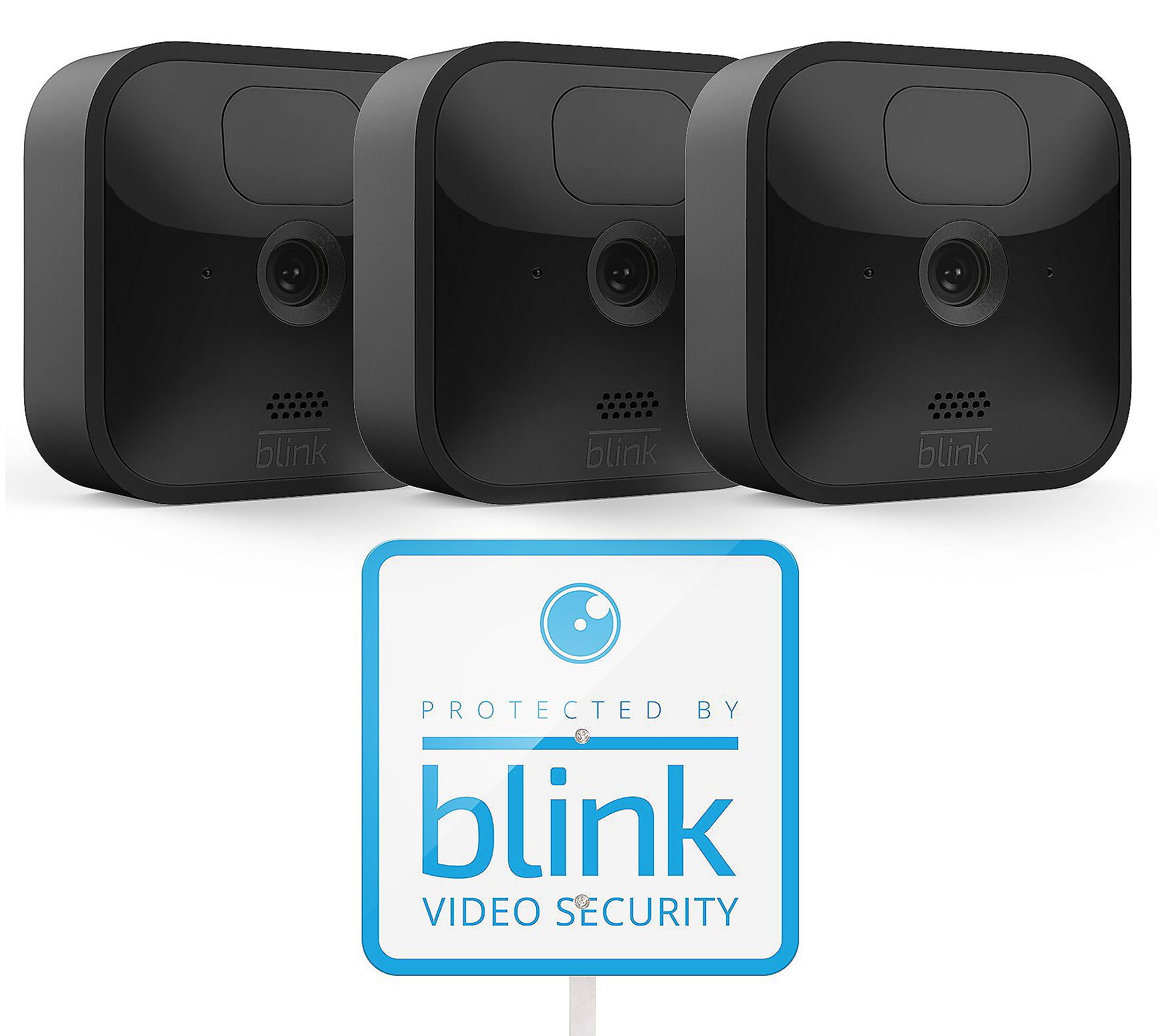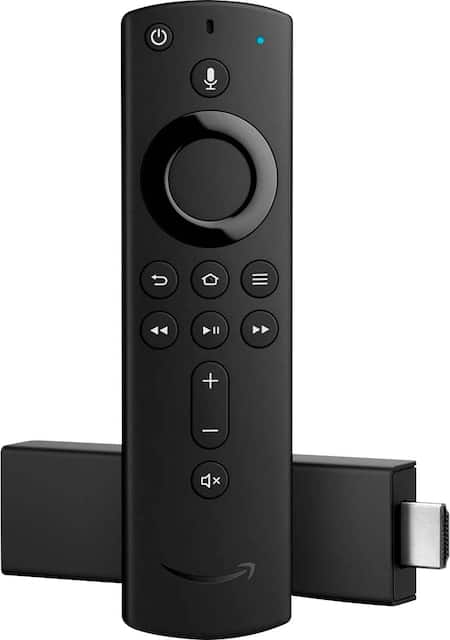Blink Outdoor / In Home 3pk Wireless Cameras with Yard Sign
Includes three Blink Outdoor cameras with three mounting kits, Sync Module 2, USB cable, power adapter, six AA lithium batteries, yard sign, and quick-start guide; 30-day Blink subscription trial. 1080p HD video at up to 30fps. 110-degree diagonal field of view. Supports 2.4Ghz Wi-Fi. Motion-activated alerts.
When it comes to keeping an eye on your home, don’t blink…
Actually, on second thought, DO Blink. Blink in the front of your home. Blink inside your home. Or over the garage door. Blink all over your place!
These Blink Outdoor wireless cameras stand up to the outdoor elements, but they’re equally at home inside. They see what’s happening around your home, remaining vigilant for you.
The three cameras connect to the all-new Sync Module 2 and your home’s Wi-Fi. You can access a live view and two-way audio over your smartphone via the Blink Home Monitor app — no matter where you are.
Each camera is powered by two AA lithium batteries (included), so all you need to do is simply replace the batteries when they’re out of juice — after about two years of normal use.
Thanks to a 30-day Blink trial subscription included in this bundle, you’ll be able to store and save videos and photos. You can also save them locally to the Sync Module 2 using a USB flash drive (not included) — without batting an eye. From Blink.
- Includes three Blink Outdoor cameras with three mounting kits, Sync Module 2, USB cable, power adapter, six AA lithium batteries, yard sign, and quick-start guide; 30-day Blink subscription trial
- 1080p HD video at up to 30fps
- 110-degree diagonal field of view
- Supports 2.4Ghz Wi-Fi
- Motion-activated alerts
- Live View with two-way audio
- Infrared night vision
- Temperature monitoring
- With long-lasting battery life, Blink Outdoor runs up to two years on two AA lithium batteries when used as directed with normal use
- For use with free Blink Home Monitor app; requires iOS 10.3 or Android 5 or newer operating systems
- Alexa-compatible
- Weather-resistant HD security cameras built to withstand the elements to help you protect your home inside or out
- Sync Module 2: USB port for local storage; flash drive (required for local storage) not included
- Each measures approximately 2.8″ x 2.8″ x 1.34″
- UL listed adapter; 1-year LMW
- Imported
A home, or domicile, is a space used as a permanent or semi-permanent residence for one or more human occupants, and sometimes various companion animals. It is a fully- or semi-sheltered space and can have both interior and exterior aspects to it. Homes provide sheltered spaces, for instance rooms, where domestic activity can be performed such as sleeping, preparing food, eating and hygiene as well as providing spaces for work and leisure such as remote working, studying and playing.
Physical forms of homes can be static such as a house or an apartment, mobile such as a houseboat, trailer or yurt or digital such as virtual space. The aspect of 'home' can be considered across scales; from the micro scale showcasing the most intimate spaces of the individual dwelling and direct surrounding area to the macro scale of the geographic area such as town, village, city, country or planet.
The concept of 'home' has been researched and theorized across disciplines – topics ranging from the idea of home, the interior, the psyche, liminal space, contested space to gender and politics. The home as a concept expands beyond residence as contemporary lifestyles and technological advances redefine the way the global population lives and works. The concept and experience encompasses the likes of exile, yearning, belonging, homesickness and homelessness.
Outdoor(s) may refer to:
- Wilderness
- Natural environment
- Outdoor cooking
- Outdoor education
- Outdoor equipment
- Outdoor fitness
- Outdoor literature
- Outdoor recreation
- Outdoor Channel, an American pay television channel focused on the outdoors
A sign is an object, quality, event, or entity whose presence or occurrence indicates the probable presence or occurrence of something else. A natural sign bears a causal relation to its object—for instance, thunder is a sign of storm, or medical symptoms a sign of disease. A conventional sign signifies by agreement, as a full stop signifies the end of a sentence; similarly the words and expressions of a language, as well as bodily gestures, can be regarded as signs, expressing particular meanings. The physical objects most commonly referred to as signs (notices, road signs, etc., collectively known as signage) generally inform or instruct using written text, symbols, pictures or a combination of these.
The philosophical study of signs and symbols is called semiotics; this includes the study of semiosis, which is the way in which signs (in the semiotic sense) operate.
Wireless communication (or just wireless, when the context allows) is the transfer of information (telecommunication) between two or more points without the use of an electrical conductor, optical fiber or other continuous guided medium for the transfer. The most common wireless technologies use radio waves. With radio waves, intended distances can be short, such as a few meters for Bluetooth or as far as millions of kilometers for deep-space radio communications. It encompasses various types of fixed, mobile, and portable applications, including two-way radios, cellular telephones, personal digital assistants (PDAs), and wireless networking. Other examples of applications of radio wireless technology include GPS units, garage door openers, wireless computer mouse, keyboards and headsets, headphones, radio receivers, satellite television, broadcast television and cordless telephones. Somewhat less common methods of achieving wireless communications involve other electromagnetic phenomena, such as light and magnetic or electric fields, or the use of sound.
The term wireless has been used twice in communications history, with slightly different meanings. It was initially used from about 1890 for the first radio transmitting and receiving technology, as in wireless telegraphy, until the new word radio replaced it around 1920. Radio sets in the UK and the English-speaking world that were not portable continued to be referred to as wireless sets into the 1960s. The term wireless was revived in the 1980s and 1990s mainly to distinguish digital devices that communicate without wires, such as the examples listed in the previous paragraph, from those that require wires or cables. This became its primary usage in the 2000s, due to the advent of technologies such as mobile broadband, Wi-Fi, and Bluetooth.
Wireless operations permit services, such as mobile and interplanetary communications, that are impossible or impractical to implement with the use of wires. The term is commonly used in the telecommunications industry to refer to telecommunications systems (e.g. radio transmitters and receivers, remote controls, etc.) that use some form of energy (e.g. radio waves and acoustic energy) to transfer information without the use of wires. Information is transferred in this manner over both short and long distances.
With or WITH may refer to:
- With, a preposition in English
- Carl Johannes With (1877–1923), Danish doctor and arachnologist
- With (character), a character in D. N. Angel
- With (novel), a novel by Donald Harrington
- With (album), a 2014 album by TVXQ
- With (EP), a 2021 EP by Nam Woo-hyun
The yard (symbol: yd) is an English unit of length in both the British imperial and US customary systems of measurement equalling 3 feet or 36 inches. Since 1959 it has been by international agreement standardized as exactly 0.9144 meter. A distance of 1,760 yards is equal to 1 mile.
The US survey yard is very slightly longer.






by Yankee
they show the nighttime view as clear as a bell – they are not. the day time views are good. i am still struggling to mount two of them. i broke on the of the right angle things, so now I don’t know what to do. I’ve gone to Amazon but they don’t seem to have anything that will work as a mount for this mode. In fact, I can’t find this model Blink anywhere.
by Hane
We started with 3 cameras. Good system for what we need. Came back and purchased another 2 for other areas. We like the option of disarming or arming on our phone, and when away can see what’s going on at home. Night vision good. Helps when an additional light is on near the camera to see even better. Only hiccup is we need to purchase the white covers and unable to find.
by Shawn
We have had Blink for 2-3 years and never had any major issues with it. One time it was our own wifi but the cameras are great! If you have your camera set up in a high traffic area, expect the batteries to die sooner than 2 years. We bought a solar panel for our high traffic camera and the other cameras have never been changed. I’m getting this new unit because we want to 2-way talk and to add to our unit.
by Wendy
The cameras do go off when motion is detected which cause the batteries to not last as long as stated, but we are able to see everything that goes on around our house and that is what matters most. We have see coyotes and foxes come down looking for food so we also know what type of wild animals are in the area. Best purchase ever.